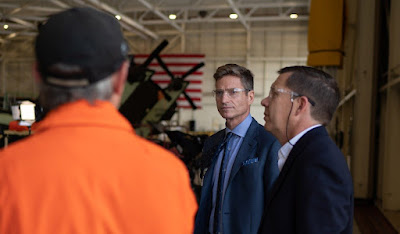The Pentagon should start electronically connecting its most important weapons first as it builds a broader strategy to link everything on the battlefield, the head of the world’s largest defense contractor says.
Lockheed Martin CEO Jim Taiclet also believes companies should help write the technical standards for the Pentagon’s effort, just as private industry did with mobile phone standards in the 1990s that laid the foundation for the current generation of commercial wireless.
“There's a lot of ways to get there, but I think the only feasible way is to literally start connecting individual platforms together within a technology roadmap, that plans for…the best combinations of existing and new platforms to create a network effect and thereby, greater returns, capability, and also greater effectiveness, if deterrence is not successful,” Taiclet said in an interview.
Defense Secretary Lloyd Austin in May signed off on the Pentagon’s connect-everything strategy, called Joint All Domain Command and Control, or JADC2, but the document itself is classified.
Lockheed has created its own, classified roadmap for digitally connecting its weapons to one another.
“I really want to drive our 5G.mil architecture,” Taiclet said. “That architecture is going to be open [so] others can tie on to it, but I think since we have really strong platform positions with all the services and all the domains, Lockheed Martin can be a real pathfinder for the industry here.”
The classified roadmap “demonstrates that you can create network effects incrementally over time, using a common open architecture. And I want to demonstrate [that] by the end of my second year at Lockheed Martin was actually doing [that],” he said.
Taiclet points to Project Hydra, an effort that connected F-22 and F-35 fighter jets using a high-flying U-2 spy plane as a digital communications relay. Lockheed built all three planes, but bespoke military specs prevented the aircraft from electronically sharing data with one another.
“It was one of a number of demonstrations we've done on live exercises with customers, but it's just the beginning of that product technology roadmap, where we start backward integrating existing platforms, and then forward innovating new ones that come along,” Taiclet said.
Lockheed itself has prioritized 14 “key technologies” across six military mission areas where it plans to make investments. Advanced communications and 5G is the top technology.
“We're trying to prepare the ground for tangible progress,” Taiclet said.
Taiclet, a former Air Force pilot who spent more than two decades in the telecom industry, made connecting weapons with 5G technology among his top priorities when he became Lockheed’s CEO a year ago—an effort he calls 5G.mil. It’s a big shift for a company long known for its combat jet fighters and cargo planes.
Since then, Taiclet has formed new partnerships between Lockheed and commercial companies, including wireless giant Qualcomm. Lockheed is working with startup Omnispace to deliver 5G signals to Earth from satellites. In May, Lockheed signed a deal with General Motors to develop a new lunar rover for astronauts to drive around the Moon.
Threats to the United States, mostly from China and Russia, are, in part, driving Taiclet’s technology priority list, which also includes artificial intelligence, machine learning, autonomy, cyber, electronic warfare, directed energy, and hypersonics.
Taiclet faces two early tests. First, the Pentagon is considering cuts to the F-35 stealth fighter, a project that accounts for about one quarter of the company’s $60-plus billion in annual revenue. Military officials are concerned about the long-term costs of the plane and top Air Force generals are already focusing on a new generation of warplanes, even though they say the F-35 will be the cornerstone of the fleet.
“We want to build a stronger connection directly to the [military] services to figure out how they want to work with us to sustain their aircraft,” Taiclet said.
Then there’s Lockheed’s planned acquisition of Aerojet Rocketdyne, a $4.4 billion deal getting extra scrutiny from the Federal Trade Commission. Taiclet believes the deal will better position the company to compete for hypersonic weapon, missile defense, and space projects.
It’s up to Frank St. John, the company’s chief operating officer, to put Taiclet’s vision into action. And changing the culture of the company so it operates more agilely and effectively across its businesses by using digital tools has not been a cake walk.
“Let me tell you, it is a big challenge,” St. John said last week at a National Defense Industrial Association conference. “I will tell you that two years ago, if you had asked me, ‘What's the biggest challenge in terms of becoming more agile and transforming digitally?’ I would have said it’s the culture.”
St. John said there is a “a whole group of people,” largely in the company’s middle management ranks, that has “built their career and been very successful doing it the old way.” That, resistance has lessened with time, he said.
“We now have that middle layer of the organization competing with each other to see how can I implement digital tools on my program,” he said.
























1 Comments
The King Casino: Recipes in PA
ReplyDeleteLearn 더킹 vip 카지노 the recipes for The 바카라 카지노 King Casino in PA to bring you all the 더킹 카지노 주소 recipes you need! Learn about 메리트 카지노 The King casino, 샌즈 카지노 가입 쿠폰 poker, card games, restaurants.